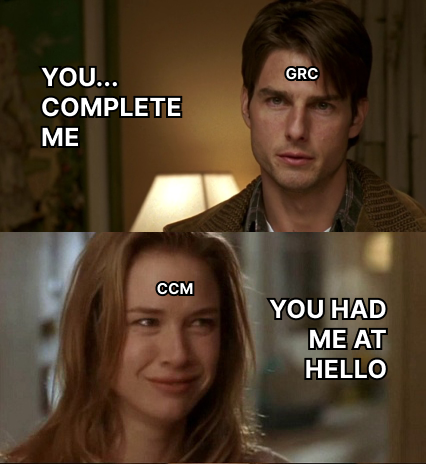GRC and Continuous Controls Monitoring, You Complete Me
Published 01/25/2024
Originally published by RegScale.
Many large enterprises have invested heavily in Governance, Risk, and Compliance (GRC) tools over the last 20 years. These investments were driven by the need to improve the organization’s compliance posture, enhance its risk management practices, and generate operational efficiencies.
While most organizations saw initial gains from their GRC investments, it was far from the promised land envisioned by the initial vendors. Over time, GRC programs became bloated, outdated, and increasingly expensive to maintain.
We mainly hear these five most common complaints about GRC tools:
- Complexity: Legacy GRC tools are often complex and require significant time and resources to configure and maintain.
- Lack of Integration: They may not seamlessly integrate with other systems and data sources, leading to data silos and inefficiencies.
- Outdated Technology: Many legacy GRC tools use outdated technology stacks, making them less adaptable to modern cybersecurity threats and compliance requirements.
- Limited Agility: Legacy GRC tools struggle to adapt to changing regulations and evolving business needs, leading to compliance gaps and increased risk.
- High Costs: These tools can be expensive to license, implement, and maintain, with a high total cost of ownership (TCO) over time.
The result of these problems is that GRC has often become a bad word in the industry, and there is no faster way to shut down a conversation in the bar than to bring up compliance programs in their GRC with any CISO I know.
So, what happened?
GRC seemed like such a panacea just a decade ago, and now it is Voldemort. Basically, IT and Cyber professionals everywhere dare not mumble their names without fear of being ostracized.
The reality is that GRC tools still serve a valuable function for compliance and risk, but the “how” they do it no longer works for most companies. With the rise of cloud computing, ephemeral/serverless systems, and container-driven architectures, documenting risk and compliance manually in web forms seems archaic, expensive, and out of touch with the direction of the IT industry.
What the world needs now is Continuous Controls Monitoring (CCM). The CCM approach extends beyond legacy GRC to provide real-time insights via automation, data-driven governance, and proactive risk mitigation.
Gone are the days of manually typing in a bunch of forms. Let automation do that!
Are you tired of maintaining and reviewing massive Word and Excel artifacts? Let Artificial Intelligence (AI) take care of that for you.

CCM offers the following benefits:
- Simplicity: Ensures rapid time to value with a purpose-built digital core based on compliance and risk best practices.
- Automatic Integrations: Plug and play with dozens of integrations.
- Cloud Native Technology: Container-based and serverless technology that auto-scales with your business needs over time.
- Enhanced Agility: Integration with regulatory change management platforms to ensure your compliance requirements are always up to date and easily mapped between frameworks.
- Cost Reduction: Get 80% of the benefit at 20% of the cost by eliminating manual labor tasks.
For organizations struggling to maintain investments in their legacy GRC systems, CCM can help alleviate many of your pain points. CCM isn’t just for the new digital native companies. CCM can complete your GRC to provide the best of both worlds: the full breadth of the industry-leading GRC platforms combined with simplicity, automation, and cost reduction by integrating CCM with your existing GRC solution.
Unlock Cloud Security Insights
Subscribe to our newsletter for the latest expert trends and updates
Related Articles:
Agentic AI Security: New Dynamics, Trusted Foundations
Published: 12/18/2025
AI Security Governance: Your Maturity Multiplier
Published: 12/18/2025
Closing the Cloud Forensics and Incident Response Skills Gap
Published: 12/16/2025
Enhancing the Agentic AI Security Scoping Matrix: A Multi-Dimensional Approach
Published: 12/16/2025





.png)
.jpeg)
.jpeg)
.jpeg)
.jpeg)